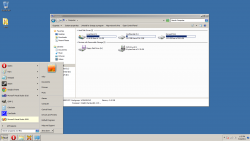Windows/Visual Styles/Windows Classic: Difference between revisions
mNo edit summary |
No edit summary Tag: 2017 source edit |
||
| (23 intermediate revisions by 12 users not shown) | |||
| Line 1: | Line 1: | ||
[[ | [[Category:Visual styles]] | ||
{{infobox Styleinfo | |||
|screenshot = Windows_7_Classic.png | |||
|screenshotcaption = Classic on Windows 7 RTM. | |||
|captionbuttons = win7rtm-captionbuttons-classic.png | |||
|startbutton = win7rtm-startbutton-classic.png | |||
|systray = win7rtm-systray-classic.png | |||
|firstseen = Chicago 4.00.81 | |||
|lastseen = Windows 7 (7601) | |||
}} | |||
'''Windows Classic''' is the name of the visual style that debuted in [[Windows 95]]. Primarily gray in appearance, it is the default theme on all versions of [[Windows|Microsoft Windows]] up until [[Windows XP]]. Several variations of this theme were released, as it was modified several times throughout the development of the Windows operating system. | |||
=== Windows 9.x === | |||
Windows 95 was the first version of Windows to include this theme, though similar styles existed in the [[Windows 3.x]] line of operating systems. | |||
[[Windows 98]] included minor changes: gradient title bars and 3D button borders around menus. | |||
=== Windows 2000 === | |||
In [[Windows 2000#beta 3|beta 3]] of [[Windows 2000]], several alterations were made. The default gray color was changed to beige, title bars were made a lighter shade of blue, and the default font was changed to Tahoma. This modified theme, called ''Windows Standard'', replaced Windows Classic as the default low-end version in subsequent versions of the operating system. | |||
=== Windows XP and Windows Server 2003 === | |||
Early builds of Windows XP, up until [[windows XP/5.1.2257.idx01.000810-2103|build 2253]], had Windows Standard as the default theme. [[Windows XP/5.1.2250.main.000628-2110|Build 2250]] slightly modified the theme, which would later evolve into the [[Windows/Visual Styles/Watercolor|Watercolor]] visual style. [[Windows XP/5.1.2428.idx01.010129-1827|Build 2428]] introduced the [[Windows/Visual Styles/Luna|Luna]] visual style; the true successor of the Windows Standard theme. | |||
<gallery | Windows Server 2003, unlike XP, kept Standard as the default theme because of speed and stability of the OS. | ||
Users who wanted the Luna theme had to enable the ''Themes'' service and restart the OS. | |||
=== Windows Vista and Windows 7 === | |||
[[Windows Vista]] retained the Windows Classic and Standard themes. | |||
Interestingly, the original version of the theme was removed from [[Windows 7]], while Windows Standard was renamed to Windows Classic. | |||
=== Windows 8 and later === | |||
[[Windows 8]] removed the visual style in favor of themes rendered by the [[Desktop Window Manager]]. However, by closing the ThemeSection handle in winlogon.exe, it is possible to run the Classic theme on Windows 8 and up, however it is really buggy. | |||
== Gallery == | |||
<gallery> | |||
Win31default.png|Windows 3.1 showing the precursor of Windows Classic | |||
Windows 95 Classic.png|Windows Classic as it appears in Windows 95 | |||
Windows 2000 Classic.png|Windows Standard as it appears in Windows 2000 | |||
Windows 7 Classic.png|Windows Standard (now known as Classic) as it appears in Windows 7 | |||
</gallery> | </gallery> | ||
Latest revision as of 14:54, 7 November 2023
 |
|
| Classic on Windows 7 RTM. | |
| Caption buttons | |
| Taskbar | |
 |
|
| Notification area | |
| First seen | Chicago 4.00.81 |
|---|---|
| Last seen | Windows 7 (7601) |
Windows Classic is the name of the visual style that debuted in Windows 95. Primarily gray in appearance, it is the default theme on all versions of Microsoft Windows up until Windows XP. Several variations of this theme were released, as it was modified several times throughout the development of the Windows operating system.
Windows 9.x
Windows 95 was the first version of Windows to include this theme, though similar styles existed in the Windows 3.x line of operating systems.
Windows 98 included minor changes: gradient title bars and 3D button borders around menus.
Windows 2000
In beta 3 of Windows 2000, several alterations were made. The default gray color was changed to beige, title bars were made a lighter shade of blue, and the default font was changed to Tahoma. This modified theme, called Windows Standard, replaced Windows Classic as the default low-end version in subsequent versions of the operating system.
Windows XP and Windows Server 2003
Early builds of Windows XP, up until build 2253, had Windows Standard as the default theme. Build 2250 slightly modified the theme, which would later evolve into the Watercolor visual style. Build 2428 introduced the Luna visual style; the true successor of the Windows Standard theme.
Windows Server 2003, unlike XP, kept Standard as the default theme because of speed and stability of the OS. Users who wanted the Luna theme had to enable the Themes service and restart the OS.
Windows Vista and Windows 7
Windows Vista retained the Windows Classic and Standard themes.
Interestingly, the original version of the theme was removed from Windows 7, while Windows Standard was renamed to Windows Classic.
Windows 8 and later
Windows 8 removed the visual style in favor of themes rendered by the Desktop Window Manager. However, by closing the ThemeSection handle in winlogon.exe, it is possible to run the Classic theme on Windows 8 and up, however it is really buggy.



